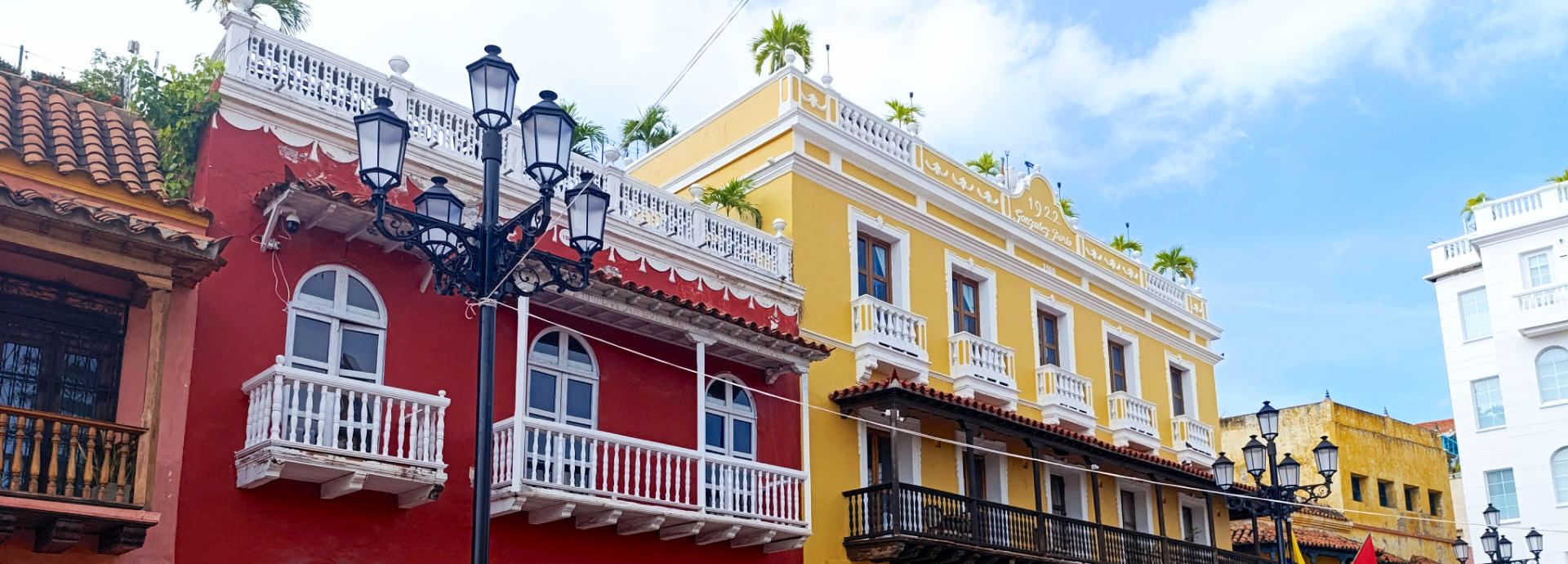
Step into the extraordinary world of Gabriel García Márquez, the master of magical realism. Let “Gabo” be your guide as you explore the places that shaped his life and work – from his birthplace in Aracataca in Colombia’s Caribbean region, through lush rainforests and along the mighty Magdalena River, to the colonial streets of Cartagena.
Immerse yourself in the magic of these places, discover the stories that made García Márquez immortal, and delve into Colombia’s vibrant culture.
Travel Destinations at a Glance:
Gabriel García Márquez, affectionately known as “Gabo,” was born in Aracataca in Colombia’s Magdalena region (likely in 1927). Raised by his grandparents, their stories, myths, and legends deeply influenced him.
After abandoning law studies in Bogotá, he began working as a journalist and writing short stories. His breakthrough came in 1967 with the novel “One Hundred Years of Solitude” (Cien años de soledad), which turned magical realism into a global literary phenomenon. This novel forms the basis of the Netflix series of the same name, released at the end of 2024.
Gabo won the Nobel Prize for Literature in 1982. He passed away in Mexico City in 2014, leaving behind a timeless legacy of poetic, richly woven tales.
Key Works:
Embark on a unique literary and real-life journey to experience Colombia’s magic.
For your independent solo trip, we suggest an itinerary that will take you to the places that deeply influenced Gabo’s life and work. Whenever possible, we recommend traveling overland and avoiding flights. Unfortunately, the train between Santa Marta and Bogotá, so memorable for Gabo, no longer exists.
The suggested itinerary starts in Bogotá and aims to minimize the distances, but of course, you can adjust it to your own needs.

Photo by Nicole (Travelhapp), Chorro de Quevedo, La Candelaria, Bogotá

Photo by Nicole (Travelhapp), Historic Center, Bogotá
Gabo frequently visited Valledupar in his younger years, when he made a living selling encyclopedias in the regions of Cesar and La Guajira in northern Colombia. His friendship with composer Rafael Escalona also took him to the nearby Manaure, where he found inspiration for a character in “One Hundred Years of Solitude”. Back then, Manaure was a popular gathering spot for bohemians and musicians. (Source – in Spanish: Bayron Araújo Campo, Panorama Cultural)
The vibrant folk culture of Valledupar influenced Gabo’s works, and he mentions the joyful city on the bright plains along the Guatapurí River in “Love in the Time of Cholera”. Gabo had a lifelong connection to Vallenato music and even served as a jury member for the famous Vallenato Festival in Valledupar in 1992. Artist Jacobo Solano created the “Cuartico de Gabo” in Valledupar, a colorful space that celebrates Gabo’s connection to Vallenato music through art (see Google Maps).
Read more about the hidden gem of Valledupar
Valledupar is located in the far north of Colombia and is easiest to reach by flight from Bogotá. From Valledupar, you can take a bus to the La Guajira Peninsula (about 3.5 hours – see Rome2Rio) or head directly to Mompox (about 4 hours) or Santa Marta (4 hours – see Rome2Rio).

Photo by Travelhapp, Valledupar Historic Center

Photo by Travelhapp, Graffiti near Cuartico de Gabo in Valledupar

Photo by Travelhapp, Cabo de la Vela, La Guajira

Photo by Mohamed Cuello, CC BY-SA 3.0, Riohacha Sea Promenade (mod.)
Gabo describes the bay of Santa Marta in “The General in His Labyrinth” as the most beautiful bay in the world. Santa Marta is considered the oldest colonial city in Latin America and was another significant source of inspiration for García Márquez. He often visited the Quinta de San Pedro Alejandrino, the historic hacienda where Simón Bolívar spent the last weeks of his life. Read more about Santa Marta.
The majestic, lush mountains of the Sierra Nevada de Santa Marta appear throughout García Márquez’s work as a mystical backdrop. You can experience this unique nature firsthand in Tayrona National Park at the foot of the Sierra Nevada, not far from Santa Marta. Learn more about hikes in Tayrona National Park.
If you take the bus from Santa Marta toward Barranquilla, you’ll pass through Ciénaga, another important place for García Márquez, and only about an hour away from his birthplace, Aracataca.
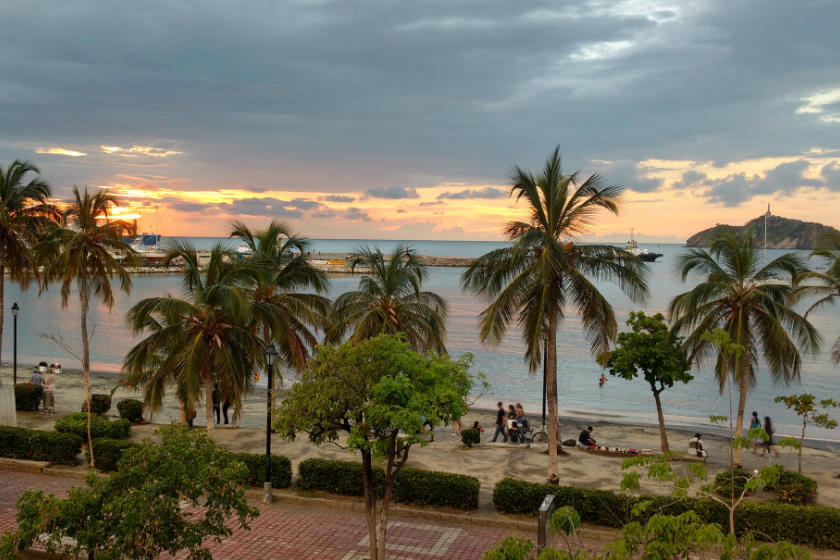
Photo by Nicole (Travelhapp), Santa Marta Bay
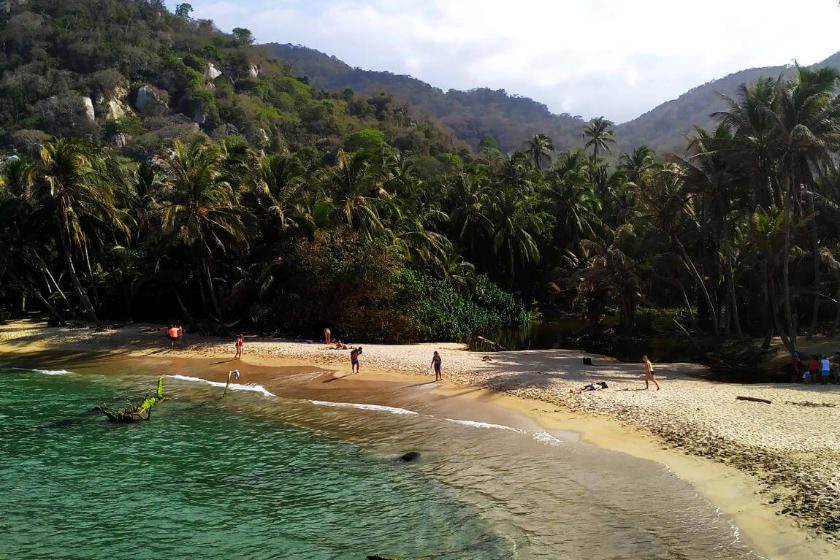
Photo by Nicole (Travelhapp), Tayrona National Natural Park
The colonial town of Ciénaga, along with the nearby Finca Neerlandia, had a significant influence on Gabo’s fictional Macondo in “One Hundred Years of Solitude”. Colonel Aureliano Buendía is partly inspired by Gabo’s grandfather, who fought in the War of a Thousand Days near Parque Plaza del Centenario in Ciénaga. The social dynamics of Ciénaga also appear in Gabo’s works.
At the so-called “Cemetery of the Rich,” the Cementerio San Miguel de Ciénaga, lies the grave of the beautiful Rosario Barranco, who is believed to have been the inspiration for Remedios the Beauty in “One Hundred Years of Solitude”.
García Márquez’s birthplace, Aracataca, is located less than an hour from Ciénaga. He lived there with his grandparents until the age of 9. Aracataca is the source of many childhood memories that found their way into Gabo’s works and was a key inspiration for Macondo.
Notable sites include:
Take a walk through the quiet, hot streets of Aracataca, and imagine Gabo as a child, listening to the stories of the elders while creating his own magical universe.
If you’re heading to Barranquilla, it’s best to stay overnight in Ciénaga and take a day trip to Aracataca. This also gives you the opportunity to visit the impressive Ciénaga Grande with its floating villages.
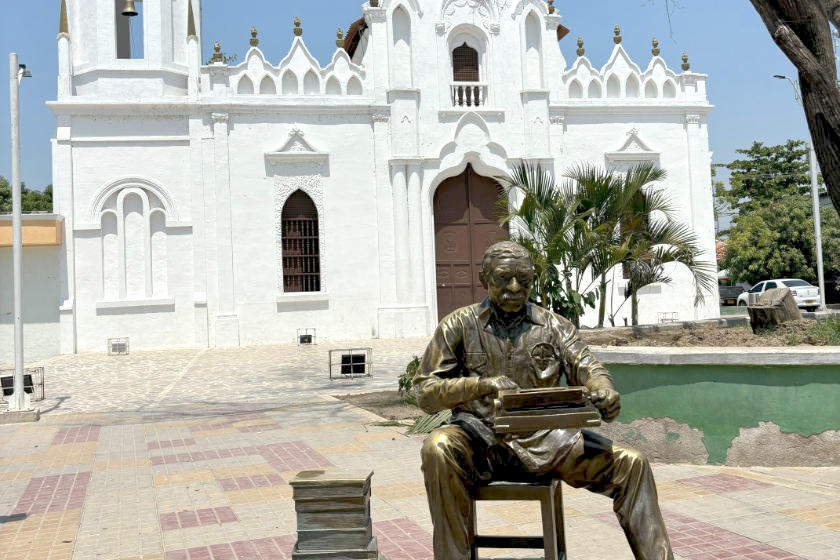
Photo by Guillermo Ramos Flamerich, García Márquez Statue in front of the church in Aracataca, CC BY-SA 4.0 (mod.)
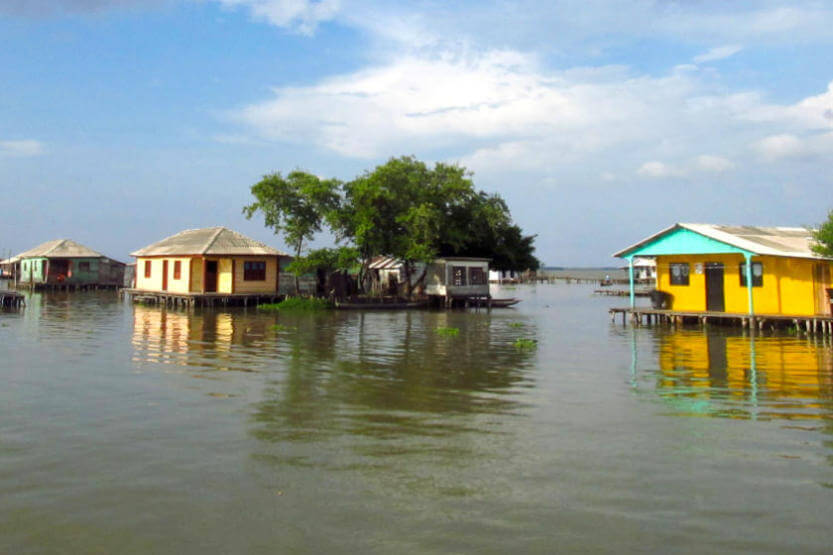
Photo by gabinete, CC BY-SA 2.0, Nueva Venecia (mod.), Ciénaga Grande
García Márquez arrived in Barranquilla in the 1950s to work as a journalist for the El Heraldo newspaper. He became part of the famous “Barranquilla Group,” a collective of intellectuals and artists who played a crucial role in his creative development. From this group, the surrealist film La Langosta Azul (The Blue Lobster) emerged.
The group initially met at Libreria Mundo and the nearby Cafe Colombia, later gathering at La Cueva bar, and eventually at La Tiendecita, now a restaurant (see Google Maps). La Cueva bar closed in 1969, was eventually restored, and is now a restaurant, museum, and cultural center (see Instagram).
Barranquilla is once again in an inspiring transformation phase and is worth visiting not only for literature enthusiasts. The city now boasts a beautiful new riverfront promenade, offering a unique chance to experience the mighty Magdalena River, which plays such an important role in Gabo’s works.
Find out what you can discover in vibrant, Caribbean Barranquilla.
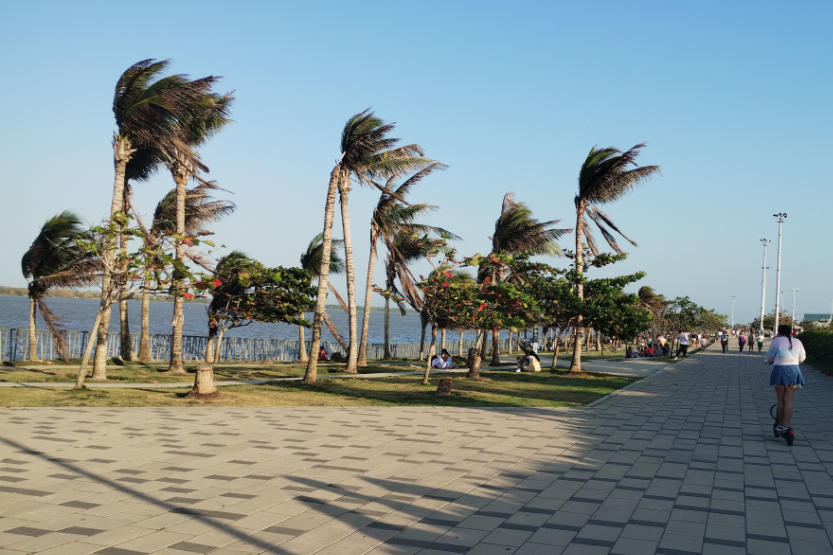
Photo by Travelhapp, Barranquilla Magdalena River Promenade
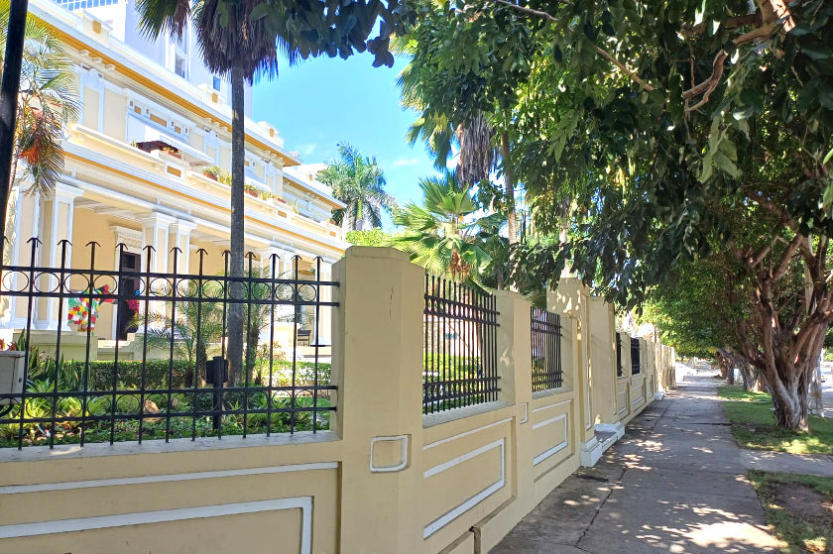
Photo by Nicole (Travelhapp), El Prado Historical District in Barranquilla
The colonial town of Mompox is sometimes compared to Sleeping Beauty, as it was long difficult to access due to its location on an island in the Magdalena River. Today, it feels as though time has stood still. Its colonial architecture is among the best-preserved in Latin America and is part of the UNESCO World Heritage sites.
When you stroll through the cobblestone streets of Mompox’s old town, you’ll understand why the city inspired Magical Realism. Its stories and legends, such as those of Santa Bárbara or the gravedigger “Cuchepa,” reflect the mysticism that Gabriel García Márquez captured in his works.
Mompox is about 4-5 hours from Valledupar, and 6-7 hours from Barranquilla and Cartagena. While it’s only about 2.5 hours from Barranquilla to Cartagena, a detour through Mompox is definitely worth it!
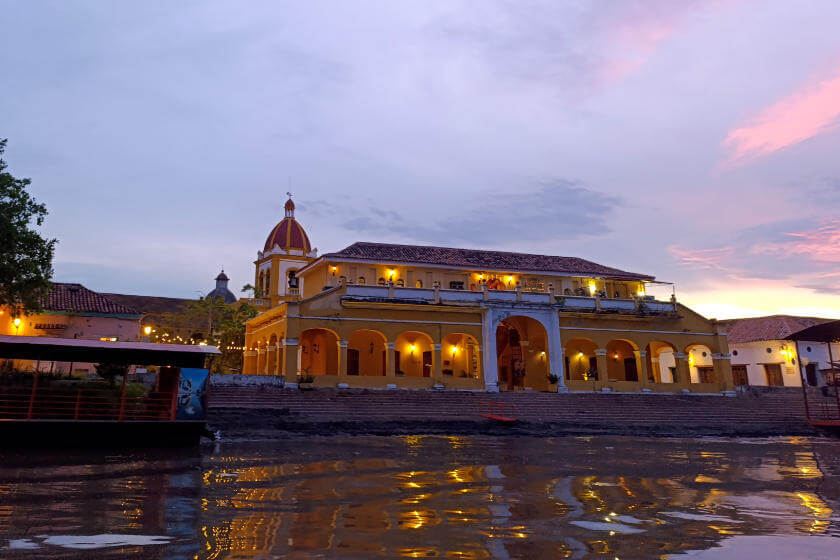
Photo by Nicole (Travelhapp), Mompox by the Magdalena river, Colombia
After the assassination of presidential candidate Jorge Eliécer Gaitán in April 1948 and the subsequent unrest in Bogotá (“Bogotazo”), García Márquez moved to Cartagena to work for the newspaper El Universal.
Cartagena, the Caribbean gem with its historic city walls, colorful colonial architecture, and narrow streets, served as the setting for “Love in the Time of Cholera”. There are special Gabo tours where you can learn more about the places featured in his stories or tied to his life – some of these tours are even free.
Here are some notable Gabo-related sights:
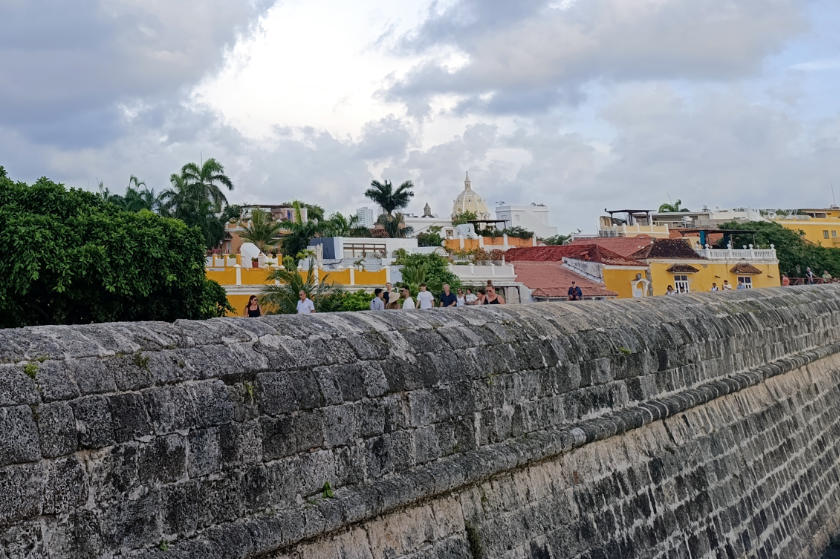
Photo by Travelhapp, Cartagena City Wall

Photo by Travelhapp, Streets of Ciudad Amurallada, Cartagena
YouTube Video (Spanish), Tío Pello, Sucre village

Photo by Travelhapp, Caribbean beach in Rincón del Mar, Sucre
The fictional town of Macondo from “One Hundred Years of Solitude” was recreated near Alvarado in the Tolima region for the Netflix series based on the novel. Four different versions of the town were built to depict the passage of time in the story.
García Márquez himself was actually against a film adaptation of the novel, as he didn’t want to limit his readers’ imagination. However, García Márquez’s children eventually agreed to collaborate with Netflix under a series of strict conditions, including that the series be produced in Colombia, in Spanish, and with a local crew.
To reach Alvarado, it’s best to fly from Cartagena to Ibagué, which is just an hour away from Alvarado. However, at the moment visitors are not allowed to access the set; negotiations are still ongoing. You can only spot “Macondo” from very far away while driving on the unpaved rural side track towards Alvarado.
However, the off-the-beaten-track Tolima region in Colombia is full of hidden gems and worth a visit in itself. Read more about the capital, Ibagué, and other interesting destinations in Tolima.
I recommend taking the bus back to Bogotá via Honda. The picturesque town of Honda lies between the Magdalena and other rivers and is also known as “The City of Bridges.” Although it’s unknown whether Gabriel García Márquez ever visited the town, it’s definitely worth the trip for fans of his works, as it perfectly reflects the atmosphere of his stories. A hidden gem in Colombia! Learn more about Honda, Tolima

Photo by Nicole (Travelhapp), Honda by the Magdalena River, Tolima
The suggested García Márquez itinerary takes you through Colombia’s Caribbean region, which features tropical climate year-round, with temperatures between approximately 28°C and 32°C during the day.
The dry season from December to March is an excellent time to visit as it’s slightly less hot, and there’s often a pleasant breeze. However, if you prefer quieter times, you should avoid the Colombian Christmas and Easter holidays (from about December 15 to January 15 and the week before Easter Sunday).
Bogotá is located at an altitude of about 2600 meters and offers spring-like to autumn-like temperatures all year.
For more information, check out my article on the best time to visit Colombia. Overall, Colombia is one of the lucky countries that feature a pleasant climate throughout the year.
Share your thoughts!
Questions or comments? I’d love to hear them! Reach out on Instagram, Facebook or TikTok.
Share this post:
Update: September 20, 2025
© 2025 Travelhapp.com
To provide the best experiences, we use technologies like cookies to store and/or access device information. Consenting to these technologies will allow us to process data such as browsing behavior or unique IDs on this site. Not consenting or withdrawing consent, may adversely affect certain features and functions. View our Privacy & Cookie Policy